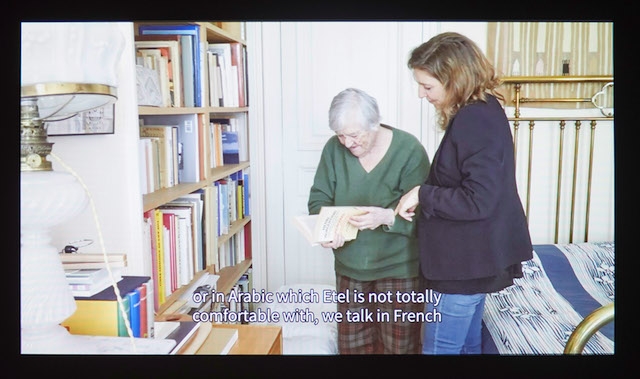The idiomatic English expression ‘from ear to ear’ can be used to describe a wide smile or a slit throat. At Nottingham Contemporary, From Ear to Ear to Eye attempts to map an alternative cartography of the Arab world by exploring sound, music and listening. Much like the ear and the eye – organs that link us to the audible and visible external world – the show’s title solicits more attentive observation to lineages, narratives and histories that meander and converge.
Featuring 17 artists of different generations from across the Arab world, this discussion across time and space is exemplified by Joana Hadjithomas and Khalil Joreige’s videowork ISMYRNE (2016), in which Hadjithomas exchanges family histories with the Lebanese-American poet and painter Etel Adnan, meditating on the transmission of memory as they imagine their shared ancestral hometown of Smyrna (the city now known as Izmir on the coast of Turkey). Nearby, Adnan’s series Leporellos (1999–2012) is presented in display cabinets: pleated panoramic, accordion-folded booklets feature fragments of hand-painted Arabic poetry and reach a width of five meters when fully extended. Though not in explicit accompaniment to the video, Adnan’s writing and paintings consider the making of history by focusing on writing as a means of recording memory, an alternative or complement to the oral tradition demonstrated in ISMYRNE. If we consider that the Leporellos might represent space and time as folded, then we see how they extend the show’s preoccupation with how the past might be bound up in the present.
A similar reflexivity occurs in Raed Yassin’s Ruins in Space (2014), a speculative fiction based on the imagined meeting of two cultural icons, Egypt’s Umm Kulthum and Korea’s Lee Nan-Young. A printed photograph of the Egyptian singer is perforated at the mouth to reveal a small speaker, through which plays a recording of Kulthum’s famous 1967 performance of al-Atlal (The Ruins) at the Olympia music hall in Paris. In Yassin’s reimagining, the song plays from outer space, a cultural crossover from the age of the space race. The singer’s voice, warbled and distorted, troubles her status as the attested ‘voice of Egypt’.
In Joe Namy’s installation Purple Bodies in Translation – Part II of A Yellow Memory from the Yellow Age (2017), the colour purple is projected onto a subtitled mirrored screen, while fragments of poetry and essays that contemplate the intricacies of translation are recounted. In one of these translator Stefan Tarnowski describes subtitling as a form of condensed translation that often fails to capture ‘the embryonic moment that occurs within the frame’
Lawrence Abu Hamdan turns ear-witness in Earshot (2016), which investigates the fatal shooting of two Palestinian teenagers through detailed acoustic analysis of the shots that killed them. The evidence against the accused Israeli soldiers is presented as testimony to a silent tribunal on a subtitled video screen. In front of the screen, spectrograms visualising the sound frequencies of rubber bullets against live ammunition when fired from a gun are suspended from the ceiling in the style of target practice sheets at a shooting range (the soldiers’ defence was that they were using rubber bullets). In this video installation, the aural is made visual and tangible.
From Ear to Ear to Eye listens and looks to the intricate connections between places, generations, histories and mediums through sound, music and aural history. It does this by redirecting the visitor’s perception of the Arab world away from the desensitising and flattened imagery propagated by Western media, and by focusing on the transmission of the aural to the visual. In doing so it offers a different means of documenting places and events that cannot be comprehended through images alone, adding a new dimension to accounts of regional identity and shared histories.
From the Spring 2018 issue of ArtReview Asia
